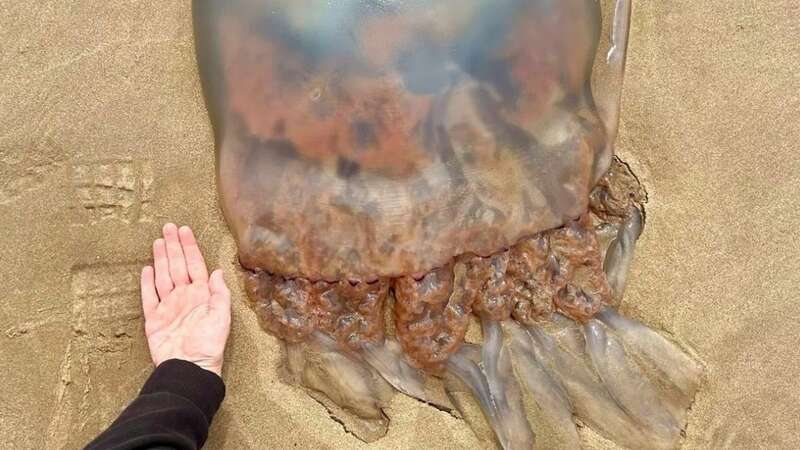
Locals at a beach in Wales say they'll 'never swim in the sea again' after one tourist shared her finds among the sand.
A gigantic jellyfish and spider crab were among the marine life leaving Brits terrified to go into the water at Barmouth, North Wales. Holidaymakers who spotted the enormous creatures shared pictures online, sparking a mixture of fascination and disgust.
Horrified beachgoers likened it to an "alien invasion" and the "stuff of nightmares". Tourist Amy Carter prompted the stunned response after sharing pictures taken by her partner Scott Southey on a local Facebook page.
The huge jellyfish is one of a number recently spotted along the stretch of coast. One person commented: "On my goodness!! Imagine swimming next to one that size. I'd freak! They are massive".
"Last time I go in the sea," declared a second, while a third wrote: "That crab could wipe out a town." Another remarked: "Seen loads on the beaches. It's amazing what nature will show us."
 Thor the Walrus returns to new UK seaside resort after New Year fireworks drama
Thor the Walrus returns to new UK seaside resort after New Year fireworks drama
 This huge mussel-encrusted crab was likened to an alien - but the species is a common sight on British beaches
This huge mussel-encrusted crab was likened to an alien - but the species is a common sight on British beachesThe jellyfish pictured is a barrel jelly, and despite its terrifying size and appearance, its stings are not typically harmful. The mussel-encrusted crab meanwhile was described by one marine life expert as a "common sight" on British beaches at this time of year, alien appearance aside.
Amy told the Daily Star: "We are having a short holiday this week and was just having a stroll down Tal-y-bont beach...we always see small crabs and jellyfish around the rocks and on the beach but was shocked to see any this size. I've been coming to Barmouth and Tal-y-bont for nearly 50 years and it's the biggest I've ever seen so I had to put my hand next to it for scale. I find it amazing to actually see the true giants of the deep."
Another similar jellyfish was discovered on nearby Dyffryn beach by Ian Wilkins who also shared his photo on the Facebook group. He told the Star: "I was shocked to see this jellyfish and the huge size that it was. Fascinating creatures."
 The 'monster' jelly was described as the 'stuff of nightmares'
The 'monster' jelly was described as the 'stuff of nightmares'Frankie Hobro, director of Anglesey Sea Zoo, said: "These are both common British species. The crab is a spiny spider crab which can grow to a foot in diameter (closely related to the King Crab) and they are common all around our coasts. We have numerous spider crabs in our aquarium exhibits, they live for many years."
"It looks as if this individual is dead, and that mussels and other marine life have taken advantage of the carcass as an anchor point - but it is equally likely that these animals were living happily on the shell of the crab while it was alive, as this is common."
"Like all crustaceans, spider crabs have to moult their outer shell to grow so it is common to find intact crab moults along our shoreline and these can be mistaken for dead crabs. In fact often in the early summer, when mass spawning and moulting occurs with thousands of spider crabs close to shore, we get beaches full of crab shells, which can appear at first glance to be a mass die-off but are in fact a positive sign of the crabs growing and breeding."
Frankie told North Wales Live: "The jellyfish shown is a barrel jellyfish, another common British species which is often found around our shores around spring and early summer - it does not tolerate warmer temperatures so is less common in summer an early Autumn when the seas are at their warmest."
"This is one of our most common jellyfish species and although they look formidable - and can grow to the size of a beer barrel, hence the name - their sting is in fact harmless to humans."
"They are the favourite food of leatherback turtles, our only native turtle species which is rarely sighted as it is usually found offshore, but they are present for over half the year, specifically to take advantage of the large numbers of large jellyfish like these which are found in the sea around the UK."
Read more similar news:
Comments:
comments powered by Disqus
































